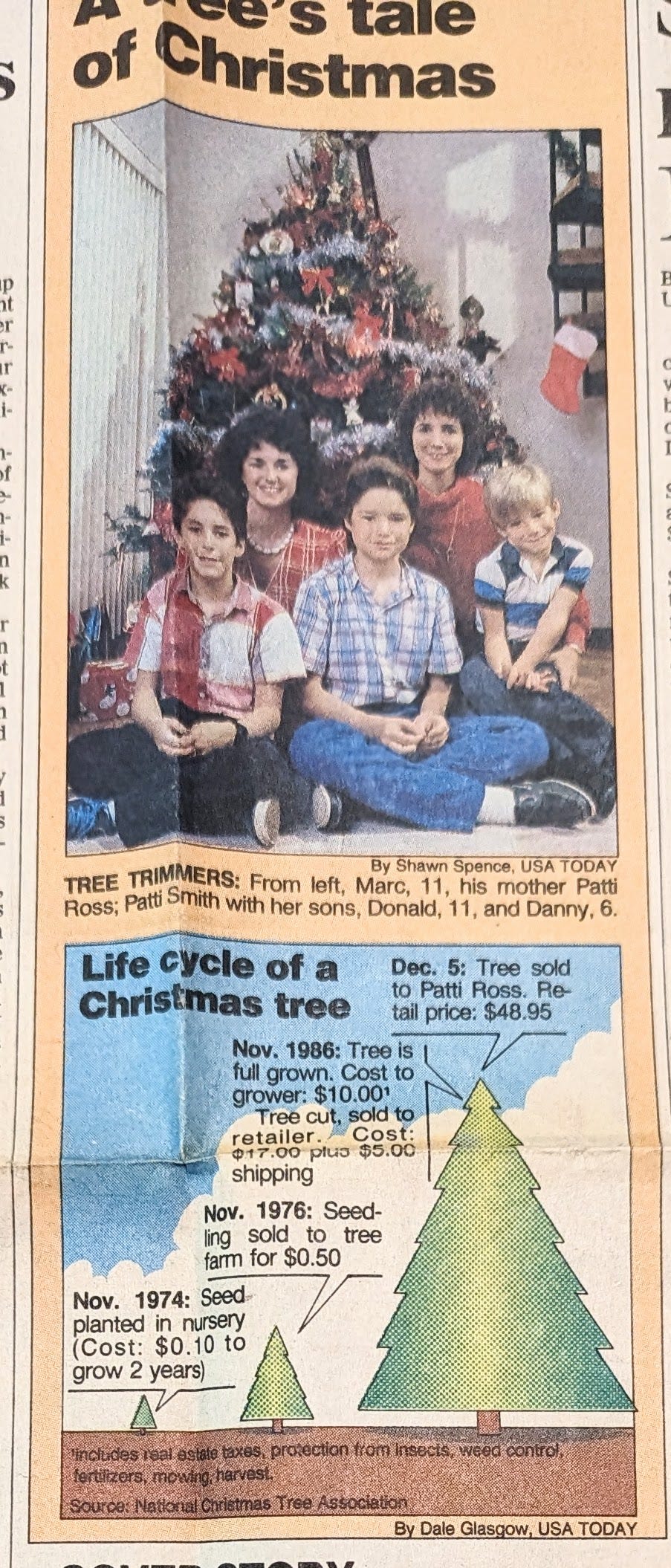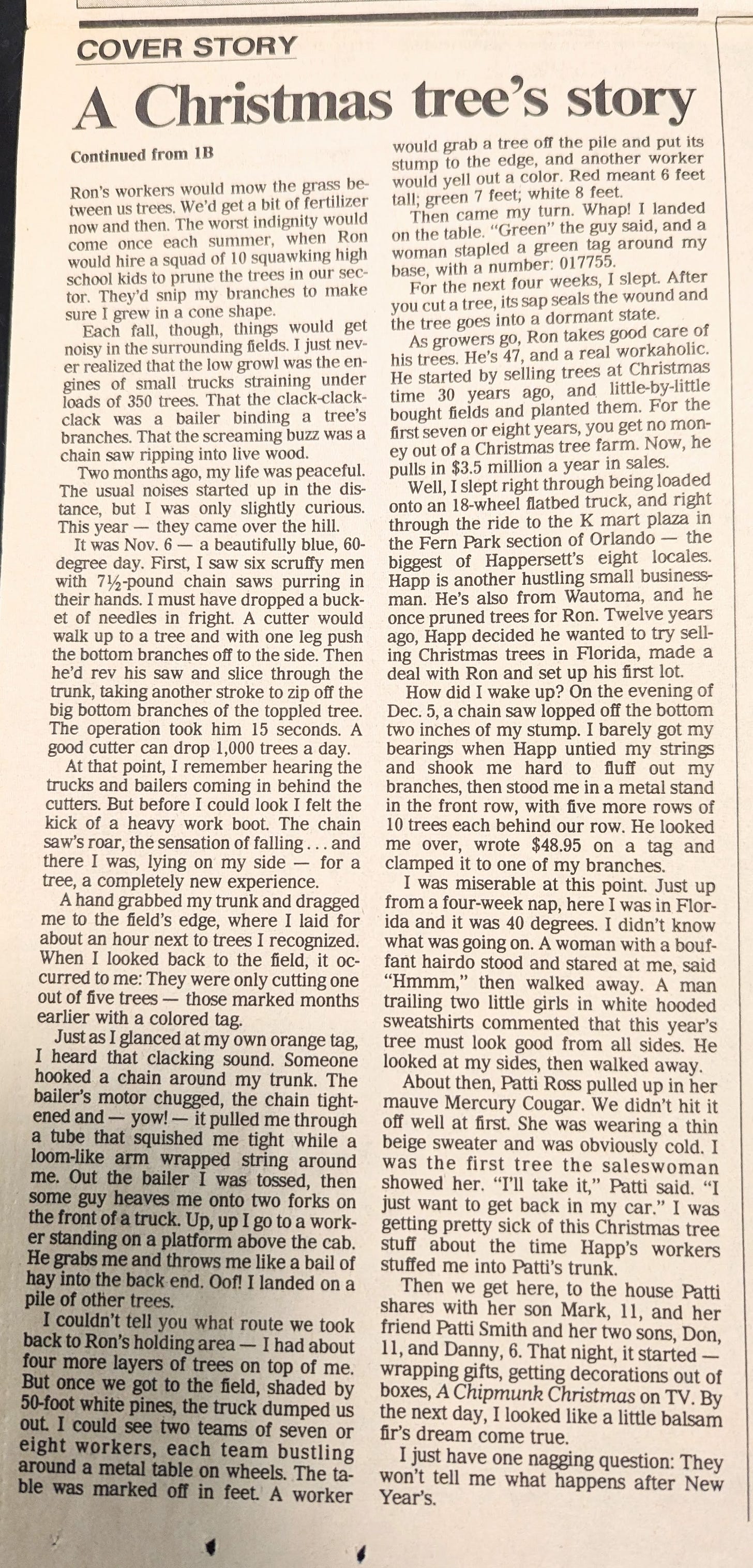A Christmas Tree Story
Or, how I delighted children and furthered my career by "interviewing" wood
A lot of young journalists first make their mark by breaking an important story. You know, like Woodward and Bernstein with Watergate.
For me, that moment came when I wrote about the business of Christmas trees…as told in first-person by an actual Christmas tree.
I’d like to see Woodward and Bernstein try to get a story out of a tree.
In the fall of 1986, I had been at USA Today for about 18 months. I was one of the youngest reporters in the newsroom -- no doubt pretty cocksure, and very determined to write with creativity and flair, which didn’t always go well because newspaper editors in those days didn’t have a lot of affinity for creativity and flair. They just wanted the facts.
I also had a thing about being handed dumb, unoriginal story assignments. And that’s what I got when an editor tromped over to my desk, perched on a corner, and told me to write a story about the business of Christmas trees.
Probably every publication on earth had at some point published a straightforward story about the business of Christmas trees. It seemed to me like a holiday story idea that editors would come up with when they couldn’t think of anything better. But I couldn’t get out of it – I didn’t have enough mojo in the newsroom to argue against an assignment. So I tried to think of how I could do the piece in a way that might be a little different.
I suggested that I follow a single Christmas tree from the time it was cut down on the farm to after it was set up in someone’s home, and describe the businesses involved. The pitch got the green light. At that point I figured I’d write it in the third person, like a typical newspaper feature.
The story required two trips. I can’t recall how I found a Christmas tree farmer willing to participate in the story, but eventually I found Ron Campbell of Campbell Tree & Land Company in Wautoma, Wisc. He had a huge operation, selling 175,000 trees a year. As I pointed out in the story, he owned a Ferrari and wore a diamond ring “the size of a pinecone.” Clearly trees were a better business than I had expected.
(An unfortunate side note: While writing this piece, I googled Campbell Tree & Land, hoping to find a web site I could link to. I couldn’t find much about the company. Then I searched Newspapers.com – a massive collection of digitized newspapers from all over the country. There, I found a 1988 story in The Steven’s Point Journal, of Steven’s Point, Wisc., that said that two years after my story, Ron Campbell was flying his single-engine plane and was killed when he crashed near the Wautoma airport.)
I traveled to Wautoma and Ron, who was a delight, showed me the inner workings of the tree industry. I learned, for instance, about how he bought “tubeling” trees from a Wayerhauser operation in California that starts the trees from seeds. Campbell would then plant the tubelings in a nursery field, and a couple years later transfer the young trees to a massive hillside field where they’d grow for another seven years.
On a pleasant 60-degree day, he took me to the hillside, and we found a nice-looking tree that would be my target. I watched as it got cut down, sorted, tagged and loaded on a truck bound for a parking-lot Christmas tree stand in Sanford, Florida. The tag allowed me to know exactly where it was going.
Several weeks later, I flew to Sanford and found the tree stand, where I must have seemed like some kind of weird lurker hanging out by that tree and taking notes about the people who came by to check it out.
It was cold for Florida – 40 degrees. A few families looked over my tree and passed. Then a woman named Patti Ross pulled up in a Mercury Cougar. Shivering, she was ready to buy the first decent tree she saw. The sales guy, trying to help me out, guided her to my tree. That’s when I had to ask her if I could follow her home and watch as she and her kids set it up. Now, how weird was that? And how weird that she agreed!
Once Patti’s household decorated the tree, my research was done. Back in the newsroom, I gathered my notes and sat there trying to figure out how to write the damn story, and came up with a crazy idea: I’d write it from the tree’s point of view, in first-person.
And yes, at a newspaper in the 1980s, that was a crazy idea. Newspapers were serious. Maybe the reporters writing about fashion or movies could have a little fun, but writing about politics or business or crime – serious! I proposed the first-person tree idea and got shot down. I asked for a chance to write it that way on spec, and if it wasn’t acceptable, I’d rewrite it more, well, seriously. I got the OK.
I started the story with the tree luxuriating in Patti’s home, feeling fancy with all the decorations and attention. In the third paragraph, I wrote: “But you wouldn’t believe what I went through to get here. What I found out most Christmas trees go through. And how much money people make off of us along the way.”
Two paragraphs later, the tree starts its story: “I was just a balsam fir on a low scooping hillside…”
When I finished and turned in that version of the story, the paper’s top editors launched into a tense debate. The “we’re respectable journalists and we don’t do this kind of thing” faction wanted to kill it. But, apparently, there was another faction that really liked it and thought it was worth taking a chance. I’m eternally thankful that the story’s defenders won out. The story was published on December 18, 1986.
The first reactions I got were within the newsroom. Some reporters were on the “we don’t do this” side and were not happy. But a greater number were super positive. The story taught people a lot about the tree business, and was just fun. And by breaking the rules and succeeding, I got noticed. It was a significant leap for my reputation.
Then it got even more satisfying. This was long before email, so it took a while to get the public’s reaction. But before long I started getting calls and letters from people who loved the story. Next came the packages of drawings kids made in school after their teachers read them the story. Some of the teachers said they were going to make it part of their lessons every year.
In the years since, a couple of times I considered the idea of working with an illustrator to turn the story into a children’s book. Never followed through and made it happen. But when I had kids, I read it to them. I’ve pulled it out and sent it or read it to others many times over the years. To this day, it is one of my favorite moments in my journalism career.
Below are images of the story as it appeared in USA Today. It’s not available online.






